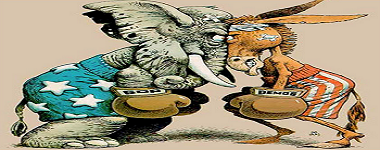Even the most casual observer of American politics knows that today’s Republican and Democratic parties seem to disagree with one another on just about every issue under the sun. Some assume that this divide is merely an inevitable feature of a two-party system, while others reminisce about a golden era of bipartisan cooperation and hold out hope that a spirit of compromise might one day return to Washington.

In this post, we present evidence that political polarization—or the trend toward more ideologically distinct and internally homogeneous parties—is not a recent development in the United States, although it has reached unprecedented levels in the last several years. We also show that polarization is strongly correlated with the extent of income inequality, but only weakly associated with the rate of economic growth. We offer several tentative explanations for these relationships, and discuss whether all forms of polarization are created equal.
To measure polarization, we make use of DW-NOMINATE (dynamic weighted nominal three-step estimation), an algorithm developed by political scientists Keith Poole of the University of Georgia, Howard Rosenthal of New York University, and Nolan McCarty of Princeton University. DW-NOMINATE uses roll call voting records to measure the underlying ideological preferences of legislators and groups legislators along two dimensions. The first can be characterized as representing the left-right divide over economic or fiscal issues, while the second captures views on regional or other cross-cutting issues (such as slavery in the mid-1800s or bimetallism later in the nineteenth century). The algorithm’s creators point out that most of the variation in roll call behavior, especially in recent years, can be accounted for by variation along the first dimension alone. Following their lead, we work with only the one-dimensional DW-NOMINATE scores. Scores run from -1 to 1, with negative values taken to indicate liberal views and positive values taken to indicate conservative views.

